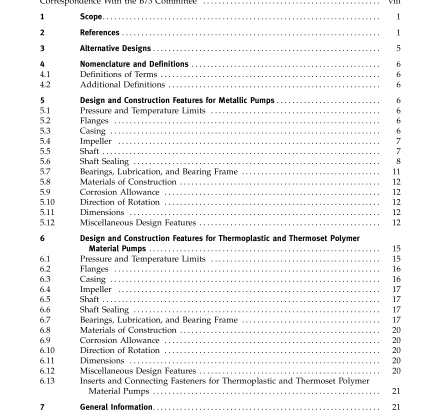ASME B73.1-2012 pdf free download.Specification for Horizontal End Suction Centrifugal Pumps for Chemical Process
4 NOMENCLATURE AND DEFINITIONS
4.1 Definitions of Terms The nomenclature and definitions of pump compo- nents shall be in accordance with ANSI/HI 1.1-1.2, except as noted below.
4.2 Additional Definitions auxiliary piping: includes all piping connected to the pump, seal chamber, packing box, or seal piping plan, excluding the main piping connected at the pump suc- tion and discharge flanges. Auxiliary piping includes piping, tubing, and all attached components, such as valves, instrumentation, coolers, and seal reservoirs. nonpressure-containing nonwetted parts: pump parts that do not contain or retain pressure and are not wetted by the pumped fluid. nonpressure-containing wetted parts: pump parts that do not contain or retain pressure but are wetted by the pumped fluid (e.g., wear ring). pressure-containing wetted parts: pump parts that contain pressure and are wetted by the pumped fluid (e.g., casing, sealing cover).
pressure-retaining nonwetted parts: pump parts that retain pressure but are not wetted by the pumped fluid (e.g., adapter, fasteners). sealing cover: refers to seal chamber, universal cover, or packing box. supplier: manufacturer or manufacturer’s representative that supplies the equipment. 5 DESIGN AND CONSTRUCTION FEATURES FOR METALLIC PUMPS Section 6 contains the design and construction fea- tures that are unique for thermoplastic and thermoset polymer pumps.
5.1 Pressure and Temperature Limits
5.1.1 Pressure Limits. Pressure limitations shall be stated by the pump manufacturer. See para. 5.8.3 for auxiliary piping.
5.1.1.1 The design pressure of the casing, sealing cover, and gland shall be atleastas great as the pressure– temperature rating of ASME B16.5 Class 150 or ASME B16.42 Class 150 flanges for the material used.
5.1.1.2 The design pressure of jackets shall be at least 100 psig (689 kPa gage) at 340°F (171°C). Heating jackets may be required for jacket temperatures to 500°F (260°C) with a reduction in pressure corresponding to the reduction in yield strength of the jacket material.
5.1.1.3 Casing, sealing cover, gland, and jackets shall be designed to withstand a hydrostatic test at 1.5 times the maximum design pressure for the particu- lar component and material of construction used (see para. 7.2.1.1).
5.1.2 Temperature Limits. Temperature limitations shall be stated by the pump manufacturer. Pumps should be availablefor temperatures up to500°F (260°C). Jacketing and other modifications may be required to meetthe operating temperature. See para. 5.8.3 for auxil- iary piping.
5.2 Flanges
5.2.1 General. Suction and discharge nozzles shall be flanged. Flange drilling, facing, and minimum thick- ness shall conform to ASME B16.5 Class 150 or ASME B16.42 Class 150 standards, except that marking requirements are not applicable and the maximum acceptable tolerance on parallelism of the back of the flange shall be 3 deg. Flanges shall be flat-faced at the full raised-face thickness (minimum) called for in the ASME standards for the material of construction. Raised-face flanges may be offered as an option. Bolt holes shall straddle the horizontal and vertical center- lines. Bolt holes may be tapped when adequate space for nuts is not available behind flanges, as noted in Table 1-1. Through bolt holes are preferred. When tapped holes are supplied, they shall be noted on the outline drawing.
5.2.2 Class 300 Option. As an option, Class 300 flanges in accordance with ASME B16.5 or ASME B16.42 may be offered with pressure ratings subject to the man- ufacturer’s casing pressure–temperature limitations. Class 300 flanges shall be flat-faced at full raised-face thickness (minimum), or raised-face flanges may be offered as an option. 5.2.3 X and Y Dimensions. All pumps, regardless offlange rating, shall conform to the Xand Ydimensions shown in Table 1-1.
5.2.4 HeavyHexNuts. Where heavy hex nuts cannot be used, the location shall be noted on the outline drawing. NOTE: ASME B16.5 and ASME B16.42 indicate the use of heavy hex nuts for certain flange connections. On many B73 pumps, heavy hex nuts cannot be used due to available space. Standard hex nuts are often substituted. The use of standard hex nuts may not allow the achievement of full bolt stress, which may impact proper gasket compression. With most gasket materials, this does not reduce the gasket’s ability to properly seal. However, this is a consideration for metallic and semimetallic (i.e., spiral wound) gaskets where significant preload may be required to achieve sufficient tightness.ASME B73.1 pdf download.ASME B73.1-2012 pdf free download
